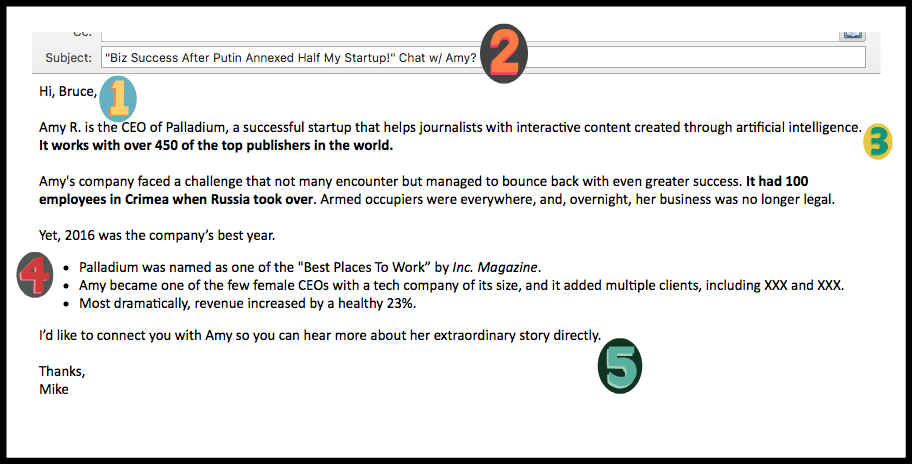
In my last post we offered eight tips on maximizing public relations success for tech clients. Now, let’s take a look at the anatomy of an effective tech media pitch.
A great softball pitcher doesn’t simply close her eyes, rear back, and heave the ball towards the batter, hoping for the best. She chooses a pitch based on the game situation, the skill of the other team, and weather conditions.
A media pitch is not very different. Let’s examine the above example. {A couple of names have been changed to protect the excellent.}
The Grip
The Grip is the part that the media outlet can’t see. All the research, preparation, and consideration ensure that the correct story will be hand-pitched to the right media. If the grip isn’t right, the pitch will fall short. The first thing we notice is a fascinating, newsworthy story. In this case, the PR pro has targeted media contact Bruce, at a top business publication, with whom he has a trusted working relationship. He knows the types of stories Bruce needs; he looks for CEO features, technology trend stories, and colorful personality profiles offering business insights. Points for Mike’s respect of this journalist’s time by not pitching him blindly.
The Stare Down
The Stare Down is the first part of the pitch the journalist sees, so it can make or break it. It’s the subject line, and it must be direct, concise, and inviting. The journalist must see the essence of the story before opening the email. It should never be misleading. If the writer opens the pitch and sees that he’s been tricked, he’s not likely not open any pitches from this PR guy again. Mike knew his client had a programming unit originally headquartered in Crimea, and that business was disrupted when Russia annexed the area in 2014. It’s not a new story, yet the founder’s decision to relocate her employees but stay in Ukraine said a lot about her and the company. And it’s highly unusual. So he let it lead, with the inspired subject line, “Putin annexed half my startup!”
The Wind-Up
The Wind-Up begins the pitch with a tantalizing start. A compelling story introduces you to the characters, gives big picture context, and offers an example that sets up conflict or suspense. It also sprinkles in details that further underscore the client company’s credibility. If the story is told well, the reader will want to know what happens next. When Bruce read “overnight, her business was no longer legal,” he wanted to know what the CEO did to save her company. But notice that Mike doesn’t go too far in explaining the rest of the story. There’s no need to oversell here.
The Release
The Release serves up the satisfying resolution of the dramatic question. In this case Amy’s company succeeded in overcoming obstacles to thrive, achieve business goals and make a prestigious outlet’s “best of” list. Normally we wouldn’t mention another publication’s coverage or endorsement in a pitch to a journalist, but in this case Mike decides to include the Inc. magazine recognition because it adds credibility for Palladium as a hot startup. He’s appealing a little to Bruce’s “fear of missing out” on a rising star, and he’s really pitching a larger story about the link between the company’s commitment to its employees and its success. He has effectively supplied a story roadmap for the journalist.
The Follow-Through
In the Follow-Through, the PR pro does two important things: He makes the ask in a polite, straightforward manner. If Bruce doesn’t respond, Mike should wait about 24 hours before following up. Further, Mike needs only follow up once before moving on. This shows that he respects the demands of Bruce’s profession.
So there’s the anatomy of an effective tech media pitch for B2B companies. However, the PR pro’s job isn’t complete. A pitcher must be ready to field the ball after the batter connects. If the reporter wants to pursue the story and the PR contact responds in a plodding, uncertain manner, it will reflect poorly on the PR team and the client. When the reporters says he wants to do the interview and plans to write a story, it’s time to get on base — arrange the interview and supply every element the outlet needs to make it home.

